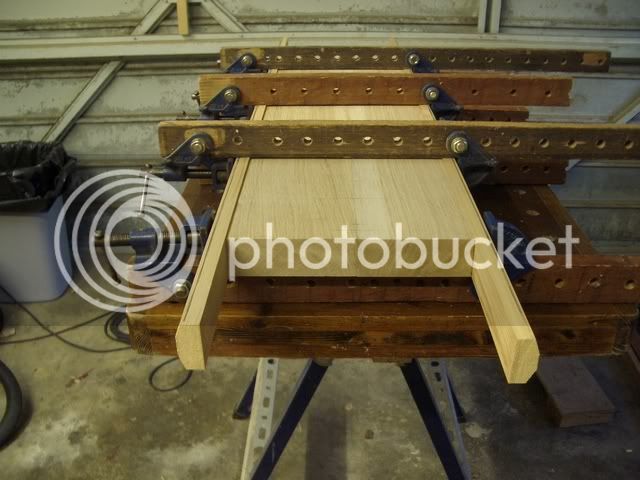joiner_sim
Established Member
(Firstly may I add, this is my first proper woodwork project on my own in my own workshop at home)
Today was the first day I actually started work on what had been put down on paper, the timber has already been machined to size for me in the commercial workshop, and is now back at my private workshop. Here is the timber waiting to be put away until needed.

After putting the rest away into storage, I got to work on jointing the top of the coffee table, which may I add is going to be cut into an oval, so I had to cramp up the boards first and work out the size of the oval so I did not put my dowels (which I'm using to join the top together) on the line of cutting. Now first time dowelling, as I'm more used to biscuit jointing, but seeing as i dont have a biscuit jointer, I've went and brought a reasonably priced dowelling jig. So had a quick practice using it and then straight down to business on the table top. I am using four planks to make up the table top, this is one of the end planks so only three 10mm dowels in this one, but for the middle joint I have put in four dowels as its a bit longer.

Obviously as this is the first time using the jig, I quickly checked after I had done the first joint that it all lined up correctly, luckily it did! Then I checked every joint as I did them just to be on the safe side. After all the joints were done, I cramped it all together dry making sure it pulled up nicely. Again it all did, so no problems so far! This being all on an evening after working all day (doing achitectural joinery) I was getting a bit tired and my workshop lighting was doing its best to lighten up the place, I wanted to call it a night, having got so far already I decided to glue up, so I did'nt have to wait tomorrow evening. I hate gluing up knowing it could become a bit of a rush because its getting late, but I did anyways, took my time and, as you can see it all went nicely!

Well then I called it a night! You can see above where i have marked the oval to be cut on, this is only for reference with the dowels, and I'll remark it again so the lines line up after they moved slightly. The picture above is the underside of the table top. The picture below, after wiping all the glue off on both sides, is showing the top of the table, the better side!
Thats it for today, hopefully will report here again tomorrow, with what will be a nicely shaped oval table top.

:arrow: Comments, Suggestions & Questions are welcomed as always
Today was the first day I actually started work on what had been put down on paper, the timber has already been machined to size for me in the commercial workshop, and is now back at my private workshop. Here is the timber waiting to be put away until needed.

After putting the rest away into storage, I got to work on jointing the top of the coffee table, which may I add is going to be cut into an oval, so I had to cramp up the boards first and work out the size of the oval so I did not put my dowels (which I'm using to join the top together) on the line of cutting. Now first time dowelling, as I'm more used to biscuit jointing, but seeing as i dont have a biscuit jointer, I've went and brought a reasonably priced dowelling jig. So had a quick practice using it and then straight down to business on the table top. I am using four planks to make up the table top, this is one of the end planks so only three 10mm dowels in this one, but for the middle joint I have put in four dowels as its a bit longer.

Obviously as this is the first time using the jig, I quickly checked after I had done the first joint that it all lined up correctly, luckily it did! Then I checked every joint as I did them just to be on the safe side. After all the joints were done, I cramped it all together dry making sure it pulled up nicely. Again it all did, so no problems so far! This being all on an evening after working all day (doing achitectural joinery) I was getting a bit tired and my workshop lighting was doing its best to lighten up the place, I wanted to call it a night, having got so far already I decided to glue up, so I did'nt have to wait tomorrow evening. I hate gluing up knowing it could become a bit of a rush because its getting late, but I did anyways, took my time and, as you can see it all went nicely!

Well then I called it a night! You can see above where i have marked the oval to be cut on, this is only for reference with the dowels, and I'll remark it again so the lines line up after they moved slightly. The picture above is the underside of the table top. The picture below, after wiping all the glue off on both sides, is showing the top of the table, the better side!
Thats it for today, hopefully will report here again tomorrow, with what will be a nicely shaped oval table top.

:arrow: Comments, Suggestions & Questions are welcomed as always

































































